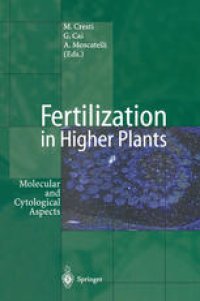
Ebook: Fertilization in Higher Plants: Molecular and Cytological Aspects
- Tags: Plant Sciences, Agriculture, Forestry, Biotechnology
- Year: 1999
- Publisher: Springer-Verlag Berlin Heidelberg
- Edition: 1
- Language: English
- pdf
Biotechnological methods are opening new ways in plant breeding. They allow novel strategies for improving crop productivity and quality, especially in the agrofood sector. The molecular mechanisms underlying these biotechnological approaches are presented here.
Topics included are: pollen development, pollen tube growth, macrosporogenesis and fertilization and the effects of pesticides on sexual plant reproduction.
Fertilization in higher plants is a complex process consisting of two events, the fusion of the egg with one sperm cell resulting in the diploid zygote, and the fusion of embryosac nuclei with another sperm cell, leading to a triploid endosperm. This "double fertilization" is preceded by the pollination process and a long lasting interaction between the dipoid pistil and the haploid pollen tube (progamic phase). Fertilization of flowering plants results in the formation of seeds and fruits, our basic food supply.
Biotechnological methods are opening new ways in plant breeding. They allow novel strategies for improving crop productivity and quality, especially in the agrofood sector. The molecular mechanisms underlying these biotechnological approaches are presented here.
Topics included are: pollen development, pollen tube growth, macrosporogenesis and fertilization and the effects of pesticides on sexual plant reproduction.
Fertilization in higher plants is a complex process consisting of two events, the fusion of the egg with one sperm cell resulting in the diploid zygote, and the fusion of embryosac nuclei with another sperm cell, leading to a triploid endosperm. This "double fertilization" is preceded by the pollination process and a long lasting interaction between the dipoid pistil and the haploid pollen tube (progamic phase). Fertilization of flowering plants results in the formation of seeds and fruits, our basic food supply.
Biotechnological methods are opening new ways in plant breeding. They allow novel strategies for improving crop productivity and quality, especially in the agrofood sector. The molecular mechanisms underlying these biotechnological approaches are presented here.
Topics included are: pollen development, pollen tube growth, macrosporogenesis and fertilization and the effects of pesticides on sexual plant reproduction.
Fertilization in higher plants is a complex process consisting of two events, the fusion of the egg with one sperm cell resulting in the diploid zygote, and the fusion of embryosac nuclei with another sperm cell, leading to a triploid endosperm. This "double fertilization" is preceded by the pollination process and a long lasting interaction between the dipoid pistil and the haploid pollen tube (progamic phase). Fertilization of flowering plants results in the formation of seeds and fruits, our basic food supply.
Content:
Front Matter....Pages I-XIII
Polyamines and Gene Expression of Biosynthetic Enzymes in Sexual Plant Reproduction....Pages 1-11
Carotenoid Biosynthesis in Plant Reproductive Organs: Regulation and Possible Functions....Pages 13-21
Lipid Accumulation and Related Gene Expression in Gametophytic and Sporophytic Anther Tissues....Pages 23-43
Sex Determination or Sexual Dimorphism? On Facts and Terminology....Pages 45-51
Meiosis....Pages 53-67
Regulation of Gene Expression During Pollen Development....Pages 69-78
Double Fertilization in Flowering Plants: Origin, Mechanisms and New Information from in vitro Fertilization....Pages 79-89
Homomorphic Self-Incompatibility in Flowering Plants....Pages 91-99
Cell Death of Self-Incompatible Pollen Tubes: Necrosis or Apoptosis?....Pages 101-112
Aspects of the Cell Biology of Pollination and Wide Hybridization....Pages 113-137
Pollen Coat Signals With Respect to Pistil Activation and Ovule Penetration in Gasteria Verrucosa (Mill.) H.Duval....Pages 139-144
Tapetum and Orbicules (Ubisch Bodies): Development, Morphology and Role of Pollen Grains and Tapetal Orbicules in Allergenicity....Pages 145-156
Development and Substructures of Pollen Grains Wall....Pages 157-173
Mechanisms of Microspore Polarity and Differential Cell Fate Determination in Developing Pollen....Pages 175-200
Genetic Control of Pollen Development and Function....Pages 201-215
The Use of the Vibrating Probe Technique to Study Steady Extracellular Currents During Pollen Germination and Tube Growth....Pages 217-233
The Role of Calcium and Associated Proteins in Tip Growth and Orientation....Pages 235-252
Measuring Ion Channel Activity During Polar Growth of Pollen Tubes....Pages 253-270
The Rheological Properties of the Pollen Tube Cell Wall....Pages 271-281
Actin Filament- and Microtubule-Based Motor Systems: Their Concerted Action During Pollen Tube Growth....Pages 283-302
The Pollen Tube Oscillator: Towards a Molecular Mechanism of Tip Growth?....Pages 303-315
MADS Box Genes Controlling Ovule and Seed Development in Petunia....Pages 317-336
Domains of Gene Expression in Developing Endosperm....Pages 337-349
Advances on the Study of Sexual Reproduction in the Cork-Tree (Quercus suber L.), Chestnut (Castanea sativa Mill.) and in Rosaceae (Apple and Almond)....Pages 351-360
Pollen as Food for Humans and Animals and as Medicine....Pages 361-375
Field Release of Transgenic Virus Tolerant Tomatoes....Pages 377-396
Grapevine Biotechnology Coming on to the Scene....Pages 397-403
Back Matter....Pages 405-412
....Pages 413-425